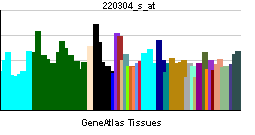Cyclic nucleotide gated channel beta 3
| Cyclic nucleotide gated channel beta 3 | |||||||||||
|---|---|---|---|---|---|---|---|---|---|---|---|
| Identifiers | |||||||||||
| Symbols | CNGB3 ; ACHM3 | ||||||||||
| External IDs | Template:OMIM5 Template:MGI HomoloGene: 40908 | ||||||||||
| |||||||||||
| RNA expression pattern | |||||||||||
 | |||||||||||
| More reference expression data | |||||||||||
| Orthologs | |||||||||||
| Template:GNF Ortholog box | |||||||||||
| Species | Human | Mouse | |||||||||
| Entrez | n/a | n/a | |||||||||
| Ensembl | n/a | n/a | |||||||||
| UniProt | n/a | n/a | |||||||||
| RefSeq (mRNA) | n/a | n/a | |||||||||
| RefSeq (protein) | n/a | n/a | |||||||||
| Location (UCSC) | n/a | n/a | |||||||||
| PubMed search | n/a | n/a | |||||||||
Cyclic nucleotide gated channel beta 3, also known as CNGB3, is a human gene.[1]
See also
References
Further reading
- Hofmann F, Biel M, Kaupp UB (2006). "International Union of Pharmacology. LI. Nomenclature and structure-function relationships of cyclic nucleotide-regulated channels". Pharmacol. Rev. 57 (4): 455–62. doi:10.1124/pr.57.4.8. PMID 16382102.
- Koenekoop RK, Lopez I, den Hollander AI; et al. (2007). "Genetic testing for retinal dystrophies and dysfunctions: benefits, dilemmas and solutions". Clin. Experiment. Ophthalmol. 35 (5): 473–85. doi:10.1111/j.1442-9071.2007.01534.x. PMID 17651254.
- Pentao L, Lewis RA, Ledbetter DH; et al. (1992). "Maternal uniparental isodisomy of chromosome 14: association with autosomal recessive rod monochromacy". Am. J. Hum. Genet. 50 (4): 690–9. PMID 1347967.
- Winick JD, Blundell ML, Galke BL; et al. (1999). "Homozygosity mapping of the Achromatopsia locus in the Pingelapese". Am. J. Hum. Genet. 64 (6): 1679–85. PMID 10330355.
- Sundin OH, Yang JM, Li Y; et al. (2000). "Genetic basis of total colourblindness among the Pingelapese islanders". Nat. Genet. 25 (3): 289–93. doi:10.1038/77162. PMID 10888875.
- Kohl S, Baumann B, Broghammer M; et al. (2000). "Mutations in the CNGB3 gene encoding the beta-subunit of the cone photoreceptor cGMP-gated channel are responsible for achromatopsia (ACHM3) linked to chromosome 8q21". Hum. Mol. Genet. 9 (14): 2107–16. PMID 10958649.
- Peng C, Rich ED, Thor CA, Varnum MD (2003). "Functionally important calmodulin-binding sites in both NH2- and COOH-terminal regions of the cone photoreceptor cyclic nucleotide-gated channel CNGB3 subunit". J. Biol. Chem. 278 (27): 24617–23. doi:10.1074/jbc.M301699200. PMID 12730238.
- Peng C, Rich ED, Varnum MD (2003). "Achromatopsia-associated mutation in the human cone photoreceptor cyclic nucleotide-gated channel CNGB3 subunit alters the ligand sensitivity and pore properties of heteromeric channels". J. Biol. Chem. 278 (36): 34533–40. doi:10.1074/jbc.M305102200. PMID 12815043.
- Johnson S, Michaelides M, Aligianis IA; et al. (2004). "Achromatopsia caused by novel mutations in both CNGA3 and CNGB3". J. Med. Genet. 41 (2): e20. PMID 14757870.
- Peng C, Rich ED, Varnum MD (2004). "Subunit configuration of heteromeric cone cyclic nucleotide-gated channels". Neuron. 42 (3): 401–10. PMID 15134637.
- Michaelides M, Aligianis IA, Ainsworth JR; et al. (2004). "Progressive cone dystrophy associated with mutation in CNGB3". Invest. Ophthalmol. Vis. Sci. 45 (6): 1975–82. PMID 15161866.
- Okada A, Ueyama H, Toyoda F; et al. (2004). "Functional role of hCngb3 in regulation of human cone cng channel: effect of rod monochromacy-associated mutations in hCNGB3 on channel function". Invest. Ophthalmol. Vis. Sci. 45 (7): 2324–32. PMID 15223812.
- Kohl S, Varsanyi B, Antunes GA; et al. (2005). "CNGB3 mutations account for 50% of all cases with autosomal recessive achromatopsia". Eur. J. Hum. Genet. 13 (3): 302–8. doi:10.1038/sj.ejhg.5201269. PMID 15657609.
- Nishiguchi KM, Sandberg MA, Gorji N; et al. (2006). "Cone cGMP-gated channel mutations and clinical findings in patients with achromatopsia, macular degeneration, and other hereditary cone diseases". Hum. Mutat. 25 (3): 248–58. doi:10.1002/humu.20142. PMID 15712225.
- Varsányi B, Wissinger B, Kohl S; et al. (2006). "Clinical and genetic features of Hungarian achromatopsia patients". Mol. Vis. 11: 996–1001. PMID 16319819.
- Bright SR, Brown TE, Varnum MD (2006). "Disease-associated mutations in CNGB3 produce gain of function alterations in cone cyclic nucleotide-gated channels". Mol. Vis. 11: 1141–50. PMID 16379026.
- Bright SR, Rich ED, Varnum MD (2007). "Regulation of human cone cyclic nucleotide-gated channels by endogenous phospholipids and exogenously applied phosphatidylinositol 3,4,5-trisphosphate". Mol. Pharmacol. 71 (1): 176–83. doi:10.1124/mol.106.026401. PMID 17018579.
- Wiszniewski W, Lewis RA, Lupski JR (2007). "Achromatopsia: the CNGB3 p.T383fsX mutation results from a founder effect and is responsible for the visual phenotype in the original report of uniparental disomy 14". Hum. Genet. 121 (3–4): 433–9. doi:10.1007/s00439-006-0314-y. PMID 17265047.
External links
- CNGB3+protein,+human at the US National Library of Medicine Medical Subject Headings (MeSH)
| Stub icon | This membrane protein–related article is a stub. You can help Wikipedia by expanding it. |
This article incorporates text from the United States National Library of Medicine, which is in the public domain.